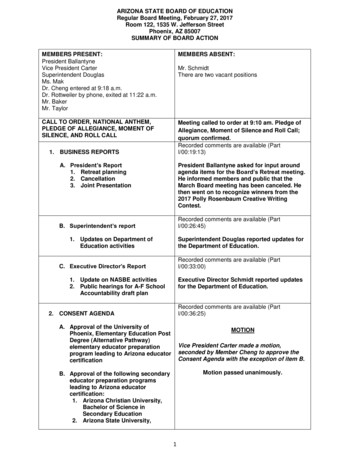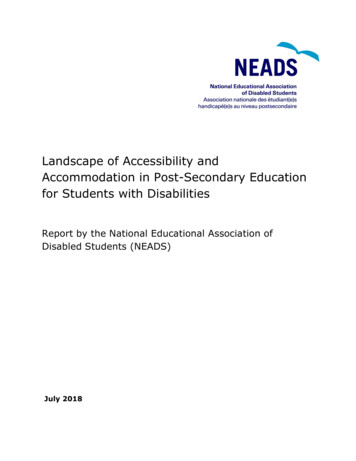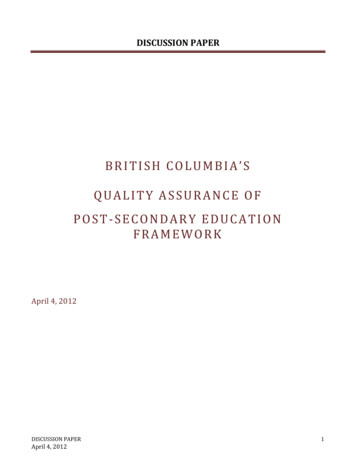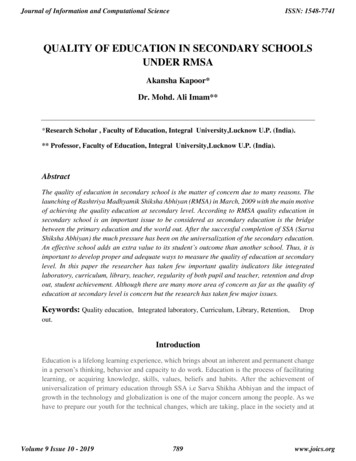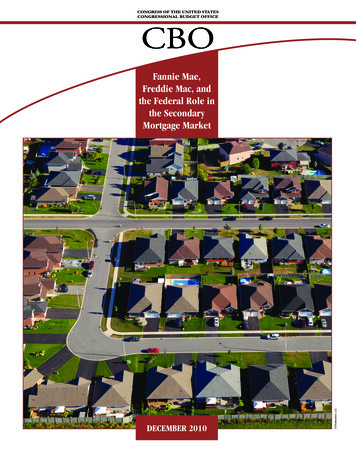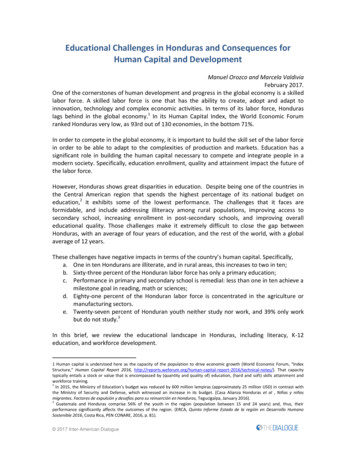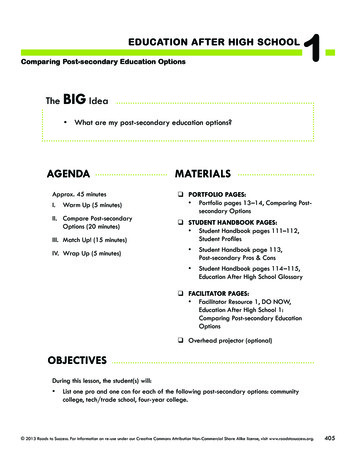
Transcription
EDUCATION AFTER HIGH SCHOOLComparing Post-secondary Education Options1The BIG Idea What are my post-secondary education options?AGENDAApprox. 45 minutesI.Warm Up (5 minutes)II. Compare Post-secondaryOptions (20 minutes)III. Match Up! (15 minutes)IV. Wrap Up (5 minutes)MATERIALS PORTFOLIO PAGES: Portfolio pages 13–14, Comparing Postsecondary Options STUDENT HANDBOOK PAGES: Student Handbook pages 111–112,Student Profiles Student Handbook page 113,Post-secondary Pros & Cons Student Handbook pages 114–115,Education After High School Glossary FACILITATOR PAGES: Facilitator Resource 1, DO NOW,Education After High School 1:Comparing Post-secondary EducationOptions Overhead projector (optional)OBJECTIVESDuring this lesson, the student(s) will: List one pro and one con for each of the following post-secondary options: communitycollege, tech/trade school, four-year college. 2013 Roads to Success. For information on re-use under our Creative Commons Attribution Non-Commercial Share Alike license, visit www.roadstosuccess.org.405
Grade 10, Education After High School 1: Comparing Post-secondary Education OptionsOVERVIEW.In this first lesson of a seven-lesson unit, students learn about post-secondary education options.The lesson opens with students sharing what they already know. Next, the facilitator fills ingaps in students’ knowledge by describing three educational options: community college, tech/trade school, and four-year college or university as students take notes. Then, students applywhat they’ve learned by matching student profiles to post-secondary options based on needs,interests, career goals, etc. Lastly, students wrap up by listing a pro and con for each postsecondary option.PREPARATION. List the day’s BIG IDEA and activities on the board. Write the day’s vocabulary and definitions on the board. Prepare a list of two local examples for each of the following post-secondary options:four-year, two-year (community college), and tech/trade schools. Make sure to highlightthese examples when you review each type of education during Activity II, ComparePost-secondary Options. In Activity II, Compare Post-secondary Options, if modeling how to take notes,prepare a transparency of Portfolio pages 13–14, Comparing Post-secondaryOptions. If working in pairs for Activity III, Match Up!, determine who will work together. Following lesson 5 of this unit, students will go on a college visit. Refer to the checklistbelow on how to plan a college visit. Talk to your administration to plan the logistics andbudget for your trip.COLLEGE VISIT CHECKLIST Contact local colleges to schedule the college visit.406 Contact your school principal to approve college choice and select specified date. In some school districts you may need to write a letter to the board explaining the tripand why it’s important. Ask your school administration if this is the case. Distribute permission slips (if not already done). Give the students an adequate amount of time to return the permission slips beforethe college visit. 2013 Roads to Success. For information on re-use under our Creative Commons Attribution Non-Commercial Share Alike license, visit www.roadstosuccess.org.
Grade 10, Education After High School 1: Comparing Post-secondary Education Options Discuss transportation expenses with your administrator. Plan, book, and pay for thetransportation to and from the college. Ask your school about its chaperone policy. Secure any additional chaperones needed. Investigate options for lunch for students (check with the school to find out what typesof payments are accepted for lunch or if lunch will be provided for the students). Establish a procedure for bringing and filling out Portfolio pages 18–21, CollegeVisit Planner (lesson 5).BACKGROUND INFORMATION. . .Post-secondary education has become a necessity in today’s workforce. According to America’sCareer Resource Network, 48 out of 50 of the fastest-growing jobs in the United Statesrequire some sort of education after high school.* While many students (and parents) perceivetraditional four-year colleges as the only legitimate form of higher education, there are manyother acceptable and accessible forms of post-secondary education, including communitycollege and tech/trade schools. These options are becoming critical providers of job training,both for degree-seekers and for students whose goals are to refine and broaden their skills.For some students, these other options may, in fact, be a better match for reasons ranging fromcareer goals to economics. It is also important to recognize that higher education is a two-waystreet: schools need to make a decision about whether a student is a good match, but a studentalso needs to decide whether the school is a good match — they need to “accept” each other.* SOURCE: .Associate’s Degree: A two-year degree, usually earned at a community college.Baccalaureate Degree: A four-year degree from a college or university. Also referredto as a bachelor’s degree.Community College: Two-year colleges that offer a degree after the completion oftwo years of full-time study.Post-secondary Education: Any education that occurs after the completion of a highschool diploma or general education development tests (GED). 2013 Roads to Success. For information on re-use under our Creative Commons Attribution Non-Commercial Share Alike license, visit www.roadstosuccess.org.407
Grade 10, Education After High School 1: Comparing Post-secondary Education OptionsCareer & Technical School: A school that provides training in occupational or vocationalareas. Many offer technical programs that prepare students for immediate entry intothe job market.IMPLEMENTATION OPTIONS.DO NOW:(You may choose to present the Warm Up activity as a written Do Now. Present the questions onthe board or overhead, and have students write only their answers on index cards. You could alsochoose to give the students a handout by copying Facilitator Resource 1, DO NOW.)Questions:1. Prediction: What fraction or percentage of today’s fastest-growing jobs requireeducation after high school? Explain why you chose this percentage. (For example,two out of five, or 40%)2. In a few sentences, explain what you currently plan to do after you graduate fromhigh school.[After they have completed their answers, call on students to read their responses. Then beginwith the Warm Up as written.]For Activity I, Warm Up, to review the vocabulary for this unit in an engaging way, you maywant to play a game with the Education After High School glossary. Read each definition aloudand instruct students to raise their hands if they can correctly identify the matching vocabularyword. The first student to correctly identify the word could receive a prize.If you want to make Activity II, Compare Post-secondary Options more student centered, askthe students the bolded questions to see what they already know about the topic.For Activity II, Compare Post-secondary Options, if you think your students will struggle toengage with the material in a lecture format, you may also want to have students jigsaw thereading in small groups. Copy the notes for each type of education listed in the facilitatorguide of this lesson. Assign students to groups of three or four. Each group should be giveninformation about one type of education. (This means that multiple groups will be readingabout the same post-secondary option.) Students should read their information and use it tocomplete their section of Portfolio pages 13–14, Comparing Post-secondary Options. Thenhave each group share one or two facts they learned about their post-secondary option. Usethis information to fill in the notes for Portfolio pages 13–14, Comparing Post-secondaryOptions on the overhead projector.408 2013 Roads to Success. For information on re-use under our Creative Commons Attribution Non-Commercial Share Alike license, visit www.roadstosuccess.org.
Grade 10, Education After High School 1: ComparingGradePost-secondary#, Unit NameEducation#: LessonOptionsTitleFor Portfolio pages 13–14, Comparing Post-secondary Options, you may choose to writenotes after you discuss each type of education, instead of writing notes while delivering thecontent. You can call on students to help fill in the blanks.For Activity III: Match-Up!, if working in pairs or small groups is not manageable in yourclassroom, have students work individually.To make Activity III: Match-Up!, more engaging you may want to create your own StudentProfile Card that describes you in high school. You can display this on an overhead projectoror chart paper and model for students why you chose the post-secondary option you pursued.For the Wrap Up, identifying “cons” requires a deeper level of thinking, going beyond directrecall. Most students should be able to identify at least one disadvantage of each postsecondary option. However, if this is too much of a challenge, have your students list two prosfor each option. To assist struggling students, you may also choose to have the students work inpairs to list the pros and cons. 2013 Roads to Success. For information on re-use under our Creative Commons Attribution Non-Commercial Share Alike license, visit www.roadstosuccess.org.409
Grade 10,#, UnitEducationName #:AfterLessonHighTitleSchool 1: Comparing Post-secondary Education OptionsACTIVITY STEPS.I. Warm Up (5 minutes)1. SAY SOMETHING LIKE: What do you want to do when you graduate high school?[Students respond.]2. SAY SOMETHING LIKE: What percentage of today’s fastest-growing jobs do youthink require education beyond high school? [Students respond.]At least 50 percent of today’s fastest-growing jobs require education after highschool, or post-secondary education.* However, this does not necessarily mean youneed to go to a traditional four-year school, which is what most people think of whenthey hear the word “college.” There are lots of different kinds of colleges. Dependingon what kind of a career you are considering, the kind of school you need varies. Inother words, not all jobs require the same type or amount of education.There are schools that train you in specific jobs, like computer programming, autorepair, nursing, etc. There are others that bridge your education between highschool and a traditional four-year college or university. And, there are colleges thatencourage you to explore a variety of subject areas before focusing on one. Theseschools prepare you for all kinds of careers, from engineering to teaching.*SOURCE: htm2. SAY SOMETHING LIKE: What do you already know about post-secondary education?What kinds of schools can you attend after high school? [Give students a couple ofminutes to respond.][As students respond, jot their ideas on chart paper. If you’d like, list students’ initialsnext to their responses to give them credit. If no one mentions the following three postsecondary options, add them to the list on the chart paper: Community college (two-year college) Career and technical school Four-year college]3. SAY SOMETHING LIKE: Great job! As you can see, there are a lot of choices forwhat to do after you graduate from high school. There are so many choices becausestudents have different needs, interests, and career goals. Just because one type ofschool is a good match for one person, it doesn’t mean it will be the right match forsomeone else.In today’s lesson, you will learn about three post-secondary education choices:community college, tech/trade schools, and four-year college. Each offers a differentkind of education.410 2013 Roads to Success. For information on re-use under our Creative Commons Attribution Non-Commercial Share Alike license, visit www.roadstosuccess.org.
Grade 10, Education After High School 1: ComparingGradePost-secondary#, Unit NameEducation#: LessonOptionsTitleII. Compare Post-secondary Options (20 minutes)1. [In this activity, explain each of the three types of post-secondary options as studentstake notes on Portfolio pages 13–14, Comparing Post-secondary Options. Theinformation about each option is presented in question-and-answer format. Pauseafter each question and answer to allow students time to fill in the handbook page.You may want to help students keep track of the important points of the lecture byusing the overhead projector to model how to complete Comparing Post-secondaryOptions. (See Implementation Options for suggestions.)]2. SAY SOMETHING LIKE: Let’s compare each of the three major types of postsecondary options: community college, tech/trade school, and four-year college/university. The more you know, the better prepared you will be to find the perfectmatch for your needs, interests, and career goals.[Refer students to Portfolio pages 13–14, Comparing Post-secondary Options.Explain that you will discuss each of the three types of post-secondary educationoptions as they take notes. Speak slowly and clearly, pausing to allow all students achance to take complete notes by filling in the blanks on the page.]3. SAY SOMETHING LIKE: Let’s start with community college. Here are some facts— some of which you probably know and others that will surprise you. Get yourpencils ready.What is a community college? Community colleges are run by your city or county. Offer an associate’s degree after the completion of two years of full-time study. Community college has two main purposes:nTo train students for immediate entry into the job market. Examples include:bookkeeper, fashion designer, computer programmer, and paramedic.nTo prepare students to transfer to a four-year college or university.Who goes to a community college? More than half the nation's undergraduates.* Governors, surgeons, actors, corporate executives, and even astronauts startedtheir post-secondary education at community college. Some have won Pulitzerand Nobel prizes! A few famous community college grads:nWalt DisneynH. Ross Perot (corporate executive, 1992 presidential candidate)nEileen Collins (NASA astronaut)nClint Eastwood, Tom Hanks, Annette Bening (actors, directors) 2013 Roads to Success. For information on re-use under our Creative Commons Attribution Non-Commercial Share Alike license, visit www.roadstosuccess.org.411
Grade 10,#, UnitEducationName #:AfterLessonHighTitleSchool 1: Comparing Post-secondary Education OptionsnnAlvin “Pete” Rozelle (NFL Commissioner)Natalie Merchant (solo artist)*SOURCE: American Association of Community Colleges: ttopresent.aspxWhy go to a community college? Transfer to four-year college – Some students start their education atcommunity college, then transfer to a four-year college. Lower cost – Costs average less than half of those at public four-yearcolleges** and about one-tenth those at private four-year colleges. Location – Can live at home, saving money on campus-living costs. Small class size – Small class sizes and personal attention from professorsor instructors. Professors focus on teaching – Professors’ main job is teaching, notresearch and publishing. Most have lots of practical experience in thesubjects they teach. Flexible class schedules – Classes offered during the day, evening, andweekends to meet the needs of students’ other commitments, such as jobsand families.**SOURCE: American Association of Community Colleges: spxCommunity college admits any high school graduate, so why do I need to workhard in high school? Community college is college. While it may be open to all, you need to havecertain skills and knowledge to succeed there, and to ultimately graduate. Thebest way to prepare for this is to practice by working hard while you’re still inhigh school. Almost 50 percent of students who enter community college end up droppingout in the first year. Those who graduate are generally the ones who workedhard in high school.4. SAY SOMETHING LIKE: Now let’s focus on career and technical schools.What are tech and trade schools? Provide courses that allow you to start a career in a specific field that youenjoy without having to take classes that really don't interest you. 412Offer a variety of options, including two-year associate’s degree programsand one- to two-year programs from which you earn a license or certificatein a specific skill. 2013 Roads to Success. For information on re-use under our Creative Commons Attribution Non-Commercial Share Alike license, visit www.roadstosuccess.org.
Grade 10, Education After High School 1: ComparingGradePost-secondary#, Unit NameEducation#: LessonOptionsTitle Offer licenses or certificates in skilled careers, such asnauto mechanicnchild care workerncomputer techniciannhairstylistnmedical assistantntruck driverninterior decoratornmechanical engineernparalegalnregistered nurseWhy go to a tech/trade school? Careers requiring an associate’s degree or some post-secondary training areexpected to grow by 17 percent through 2020 — more than five percent higherthan those requiring only a high school diploma.* Focuses on students’ and employers’ needs. Trains students in skills required for a specific type of job. Small classes and more individual attention than four-year colleges. Night and weekend courses for those who work full-time.*SOURCE: 2010 U.S. Department of Labor Bureau of Labor Statistics, Employmentby summary education and training assignment, 2010 and projected 2020,http://www.bls.gov/emp/ep table education summary.htm5. SAY SOMETHING LIKE: Finally, let’s take a look at traditional four-year collegesor universities.What is a four-year college or university? Provides a general, well-rounded education. Offers a bachelor’s degree in a specific area of study, called a major. Common fields of study include engineering, biology, business, economics,English literature, foreign languages, political science, and history. Lays the groundwork for more advanced studies and professional work(for example: you need to go to a four-year college or university beforegoing to medical school or law school).Who goes to a four-year college or university? Students who want a general academic program and the opportunity toexplore many different interests. Students preparing for “professional” careers. Examples: lawyers, doctors,teachers, architects, accountants, engineers, etc. Students who want to pursue graduate work or education after college. 2013 Roads to Success. For information on re-use under our Creative Commons Attribution Non-Commercial Share Alike license, visit www.roadstosuccess.org.413
Grade 10,#, UnitEducationName #:AfterLessonHighTitleSchool 1: Comparing Post-secondary Education OptionsWhy go to a four-year college or university? Broader knowledge – Learn skills useful both in work and in life, such as:nthinking abstractly and creativelynexpressing yourself clearly in speech and writingnmaking wise decisions More money – Most high-paying jobs require a bachelor’s degree. More job opportunities. More choice – Offers a wide variety of courses in the social sciences, humanities,and sciences. Independence – In many cases, you live away from home, on your own in a dorm.III. Match Up! (15 minutes)1. SAY SOMETHING LIKE: Who remembers what percentage of jobs require postsecondary education? [Let students answer. If no one answers correctly, remind themthat at least 50 percent of the fastest-growing jobs today require some sort ofeducation after high school.]2. SAY SOMETHING LIKE: In this activity, you will read about different students who areabout to graduate high school. Working with a partner, you will figure out which ofthe three post-secondary education options we’ve discussed today is the best choicefor each student. You may use your notes from Portfolio pages 13–14, ComparingPost-secondary Options to help you. Then, we will meet as a class again to shareand discuss your decisions. Be ready to defend your choices!2. [Divide the class into pairs. Refer students to Student Handbook pages 111–112,Student Profiles. Tell them they have five minutes to review the profiles. Instruct themto check one of the three post-secondary options that they think is the “best fit” foreach student. Remind them that they should be prepared to defend their decision in afollow-up class discussion.3. [After five minutes, have students come together for a whole-class discussion. Havevolunteers read aloud each profile, then ask pairs to share which post-secondarychoice they made and why. If a decision is unanimous, select a pair or two to justifythe choice. If a decision is not unanimous, have pairs who made different choicessupport their decision to the class.]4. [If the students finish this activity early, instruct them to create their own profile. If timepermits, have a few students share which post-secondary option they feel is the best fitfor them and why.]414 2013 Roads to Success. For information on re-use under our Creative Commons Attribution Non-Commercial Share Alike license, visit www.roadstosuccess.org.
Grade 10, Education After High School 1: ComparingGradePost-secondary#, Unit NameEducation#: LessonOptionsTitleIV. Wrap Up (5 minutes)1. [Refer students to Student Handbook page 113, Post-secondary Pros & Cons.]SAY SOMETHING LIKE: Now it’s your turn to show what you know. Complete thishandout by listing at least one benefit, or pro, for each type of post-secondaryeducation option and one disadvantage, or con.2. [Upon completing the handout, ask for volunteers to share one pro and one con foreach type of post-secondary option. Make students understand that pros and conscan be very subjective. For example, one student may find that ability to live at homewhile going to community college to be a pro, while another student may see this as anegative aspect of going to community college.]SAY SOMETHING LIKE: Whether you decide to go to a four-year college, communitycollege, or tech/trade school, you will gain knowledge and build skills that will helpyou to succeed in your career, and in your life outside of work. But, whatever choiceyou make, it’s important that you work hard now while you’re still in high school. 2013 Roads to Success. For information on re-use under our Creative Commons Attribution Non-Commercial Share Alike license, visit www.roadstosuccess.org.415
Grade 10, Education After High School 1: Comparing Post-secondary Education OptionsFacilitator Resource 1, Do NowDO NOWEducation After High School 1:Comparing Post-secondary Education OptionsDirections: You will have three minutes to read the questions and write your answers.Questions:1. Prediction: What fraction or percentage of today’s fastest-growing jobs require educationafter high school? Explain why you chose that percentage. (For example, two out of five,or 40%.)2. In a few sentences, explain what you plan to do after you graduate from high school. 2013 Roads to Success. For information on re-use under our Creative Commons Attribution Non-Commercial Share Alike license, visit www.roadstosuccess.org.
Grade 10, Education After High School 1: Comparing Post-secondary Education OptionsStudent Handbook, Student ProfilesSTUDENT PROFILESRead each student profile. Then check the post-secondary option that best fitseach student.Student 1Name:Evan BrownCareer Goal:Auto mechanicSituation:Wants to work as soon as possibleKnows he wants to work with carsLearns best in small classesPost-secondary Options:Community CollegeCareer/Technical SchoolFour-year CollegeqqqStudent 2Name:Melinda PotterCareer Goal:BookkeeperSituation:Not much money saved for collegeNeeds to be near home to care for younger siblingsHas a part-time jobPost-secondary Options:Community CollegeCareer/Technical SchoolFour-year CollegeqqqStudent 3Name:Angie GarciaCareer Goal:Something in biology-related field (maybe pediatrician)Situation:Would like to live away from home, on-campusIs interested in taking lots of different kinds of coursesWants to go to medical school one dayPost-secondary Options:Community CollegeCareer/Technical SchoolFour-year Collegeqqq 2013 Roads to Success. For information on re-use under our Creative Commons Attribution Non-Commercial Share Alike license, visit www.roadstosuccess.org.111
Grade 10, Education After High School 1: Comparing Post-secondary Education OptionsStudent Handbook, Student ProfilesStudent 4Name:Rob JohnsonCareer Goal:Investment bankerSituation:Works 9 to 5 job as a bank tellerCan’t afford to live on-campus yet, but would like to one dayWould like to make a lot of money in futurePost-secondary Options:Community CollegeCareer/Technical SchoolFour-year CollegeqqqYOUR STUDENT PROFILEName:Career Goal:Post-secondary Options:Community CollegeCareer/Technical SchoolFour-year CollegeqqqProvide three specific reasons why you believe this post-secondary option is the best fit foryou.1.2.3. 2013 Roads to Success. For information on re-use under our Creative Commons Attribution Non-Commercial Share Alike license, visit www.roadstosuccess.org.112
Grade 10, Education After High School 1: Comparing Post-secondary Education OptionsStudent Handbook, Post-secondary Options Pros & ConsPost-secondary OptionsPros & ConsList one pro and one con for each type of post-secondary option.CommunityCollegeCareer andTechnical SchoolsFour-Year Collegeor UniversityProCon 2013 Roads to Success. For information on re-use under our Creative Commons Attribution Non-Commercial Share Alike license, visit www.roadstosuccess.org.113
Grade 10, Education After High School 1: Comparing Post-secondary Education OptionsStudent Handbook, Education After High School GlossaryEducation After High School GlossaryAcademic Skills: Skills related to school subjects, such as reading, writing, and computation.ACT/SAT: Primarily multiple choice tests of mathematical and English abilities that arerequired by many colleges and universities for admission into an undergraduate program.Advanced Placement (AP) Classes: Challenging courses that give students the opportunityto earn college credit while still in high school through successfully completing end-of-thecourse exams.Associate’s Degree: A two-year degree, usually earned at a community college.Award Letter: Mailed from a college to a prospective student, states the amount and type offinancial aid the school will provide if you take classes there.Baccalaureate Degree: A four-year degree from a college or university. Also referred to asa bachelor’s degree.Campus: The grounds and buildings of a university, college, or school.Career & Technical School: A school that provides training in occupational or vocationalareas. Many offer technical programs that prepare students for immediate entry into thejob market.Practice Application : A standard application form that is accepted by almost 300 privatecolleges. It is available at www.commonapp.org and in high school counselor offices. (NOTE:Many public colleges and universities require their own application instead.)Community College: Two-year college that offers a degree after the completion of twoyears of full-time study.Expected Family Contribution (EFC): The amount your family can afford to pay for college,as calculated on the FAFSA.Facilities: Buildings on campus where specific activities occur, such as computer labs, dancestudios, sports complex, dining halls, etc.Faculty: Professors at a university, college, or school. 2013 Roads to Success. For information on re-use under our Creative Commons Attribution Non-Commercial Share Alike license, visit www.roadstosuccess.org.114
Grade 10, Education After High School 1: Comparing Post-secondary Education OptionsStudent Handbook, Education After High School GlossaryFinancial Aid: Any type of assistance used to pay college costs.Free Application for Federal Student Aid (FAFSA): Form that must be completed to receivefederal financial aid. Determines how much financial help your family can be expected tocontribute to your college education.Grant: Also called gift aid, a grant is financial aid that doesn’t have to be repaid. Grant aidcomes from federal and state governments and from individual colleges, usually on the basisof financial need.Loans: Financial aid, often from the federal government, that must be repaid.Major: Your field of specialization in college.Personal Qualities: Characteristics that tell what kind of person you are, such as leadership,dependability, and motivation.Post-secondary Education: Any education that occurs after the completion of a high schooldiploma or general education development tests (GED).Reference: A statement about a student’s ability or character.Remedial Course: A course that teaches skills required to succeed in college-level courses.Scholarships: Funds for college distributed according to requirements set by the scholarshipprovider, like excellence in academics or sports.Student Aid Report (SAR): E-mailed or mailed from the office of Federal Student Aid to thestudent after the FAFSA has been completed. Includes all the information you provided, aswell as your Expected Family Contribution (EFC).Undergraduate: A student enrolled in an associate’s or bachelor’s degree program (two- orfour-year degrees).Work-Study Program: A federal program that provides students with part-time employment,often on campus, to help meet their financial needs. 2013 Roads to Success. For information on re-use under our Cr
Grade 10, Education After High School 1: Comparing Post-secondary Education Options For Portfolio pages 13-14, Comparing Post-secondary Options, you may choose to write notes after you discuss each type of education, instead of writing notes while delivering the content. You can call on students to help fill in the blanks.
